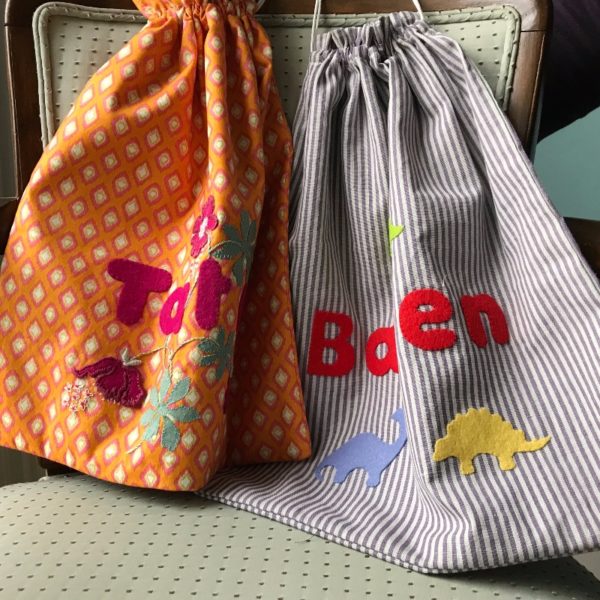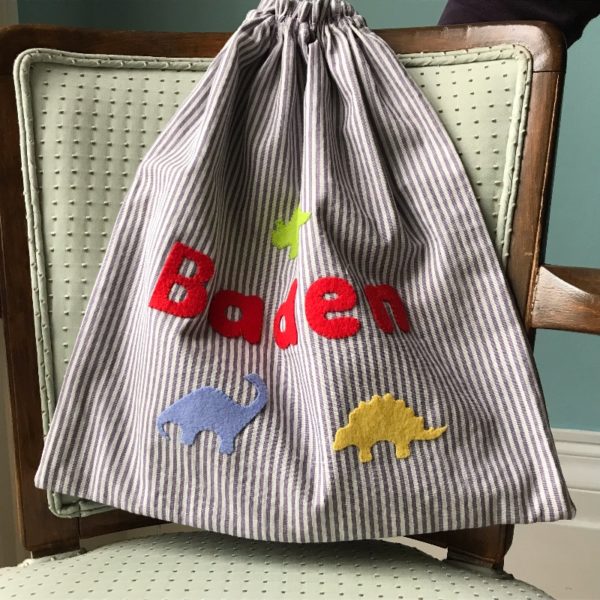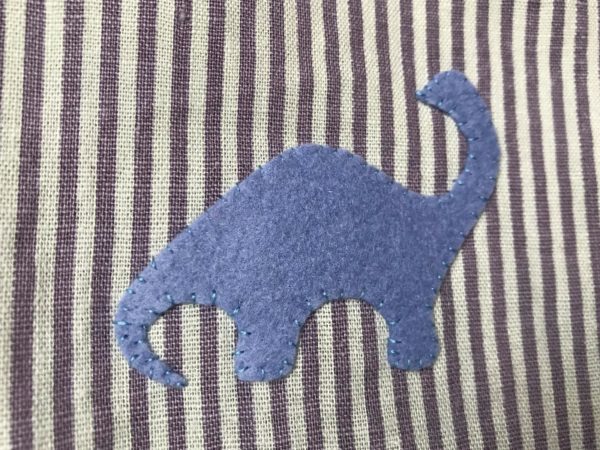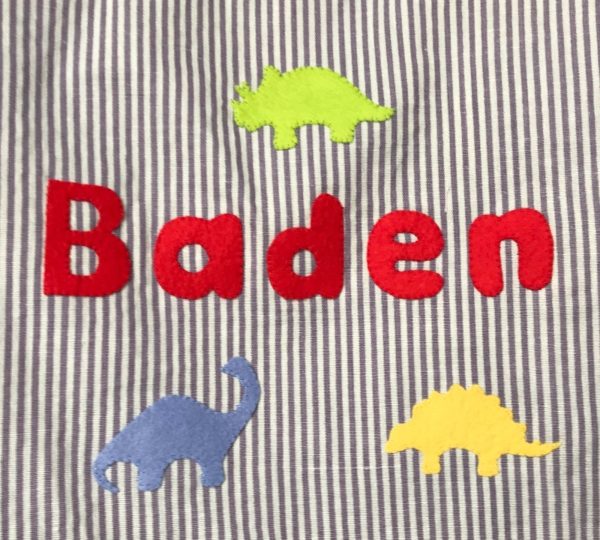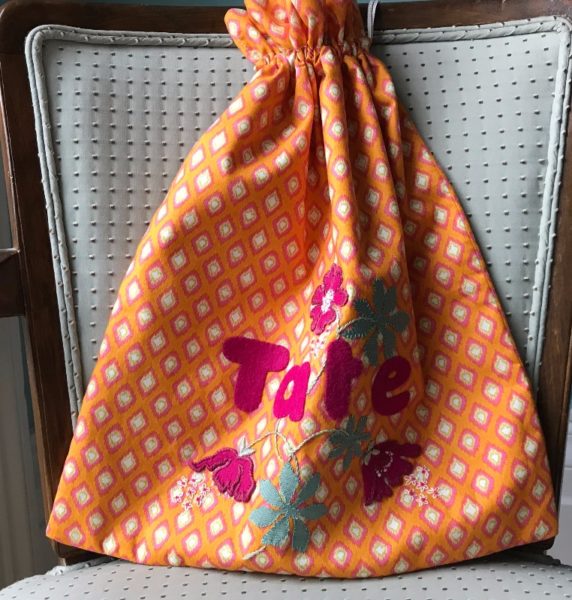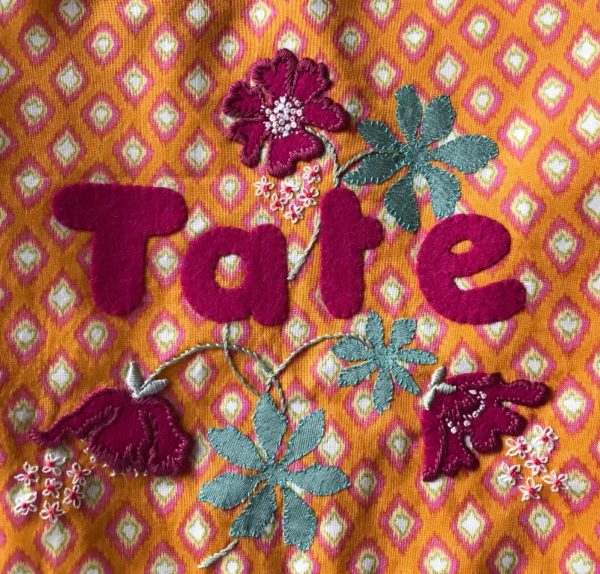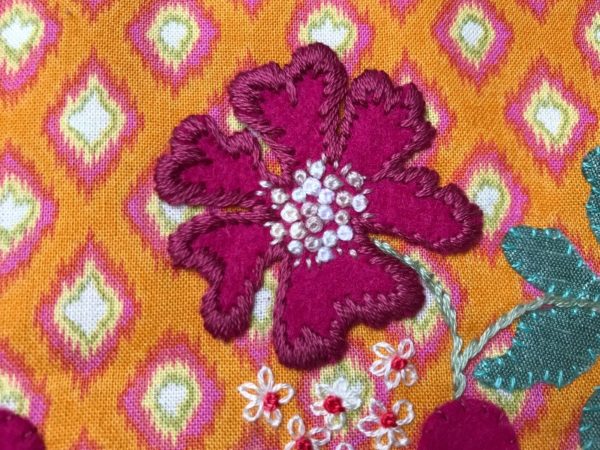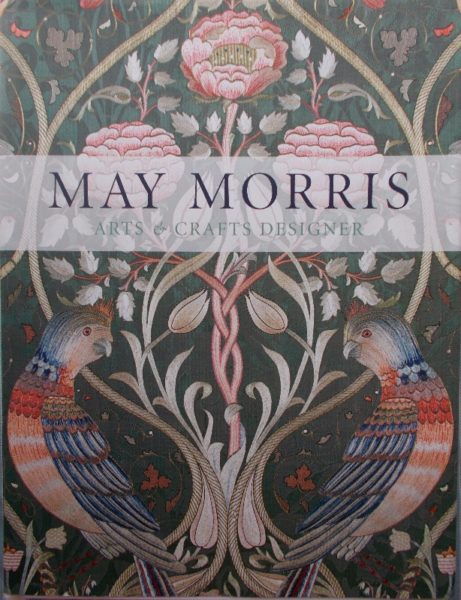
May Morris Arts and Crafts designer (pub 2017 T & H in association with the V & A)
May Morris, daughter of William Morris and his wife Jane, has always seemed an elusive figure. In photographs she often looks plain and rather bored, though to be fair photographs of William and Jane often seem a bit low key in the glamour stakes too – probably because sitting still for long enough to have your photograph taken tended to catch you with a ‘for goodness sake just get on with it’ sort of look.* Then, following your father into his business can go one of two ways, either you get the position with middling talent, follow the house style and bathe in its reflected glory or you have bags of talent which is subsumed into the lustrous reputation of the firm in general. Spectacularly up there with the design Titans, one thing is true – William Morris was a hard act to follow.
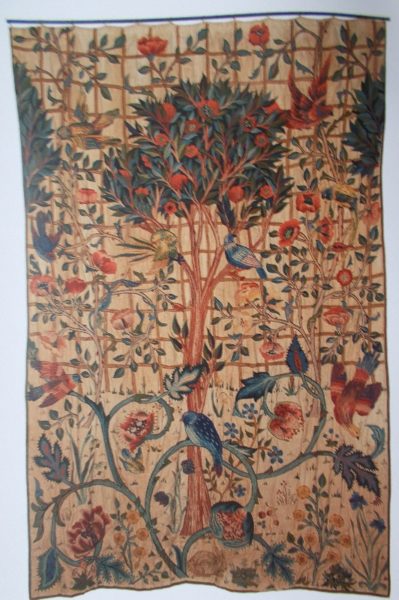
Bed curtain embroidered by May Morris; now to be seen on the bed in William Morris’s bedroom Kelmscott Manor
But there is a tide in the affairs of men and recently May’s tide has come swooshing in. Last month I read in The Times (18 October) that her journals for the interwar years – the last 20 of her life – had turned up out of the blue in a basement of the now closed Coleg Harlech, in West Wales. On the verge of being thrown into a rubbish skip along with the other detritus in the abandoned building, some discerning individual had spotted their worth and handed them to her biographer, Jan Marsh. Linda Parry’s recent scholarship (William Morris Textiles of 2013) has also put a bit of flesh on the shadowy figure and shown May to be an important designer and a substantial figure in her own right. The icing on the cake takes the form of a glorious exhibition devoted solely to May Morris and her work at the William Morris Museum in Walthamstow (on until Jan 28 2018). Some of the newly discovered journals are on display but study of these is only in the early stage.
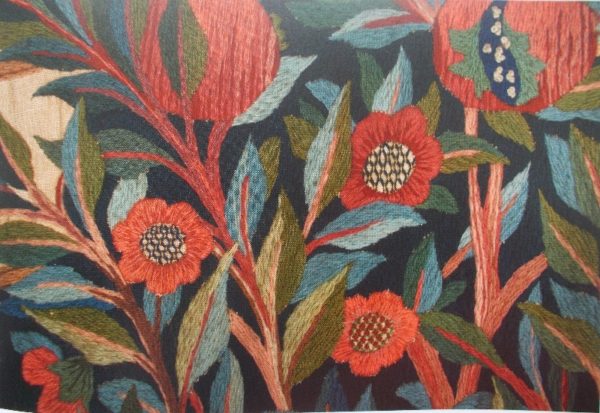
Detail of Bed curtain embroidered by May Morris; now to be seen on the bed in William Morris’s bedroom Kelmscott Manor.
The book that complements the exhibition caught my eye when I was in The Wilson, (aka Cheltenham Art Gallery and Museum). With minutes to spare before meeting my husband I found myself somewhat automatically flicking through a copy but it wasn’t long before I became more alert and less casual. The pictures of the embroidery were really very good, there were lots of them with plenty of detailed images – images so clear you could count the stitches. I just had to buy it. Once home I read it the book at one sitting – for the text was as good as the images. Six extended essays written singly or together by five writers/curators with experience in different fields put flesh on the bones of this once shadowy figure.
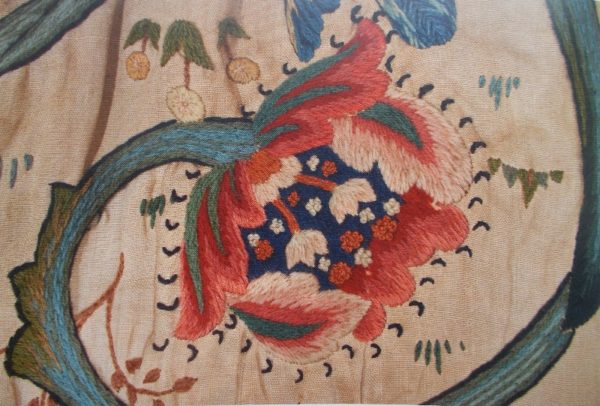
Detail ofBed curtain embroidered by May Morris; now to be seen on the bed in William Morris’s bedroom Kelmscott Manor (some long and short stitches here as well as split stitch and french knots)
May was born into a small business start up, where mother and aunt (Bessie Burden, Jane’s sister) embroidered William’s designs for sale. Jenny was 15 months older but as soon as the girls could sew they were instructed to make embroidered pen wipes and kettle holders. (A stage I hope they went through quickly for what a waste embroidering such items of rough usage!) More excitingly, when Morris experimented with dyeing, he also gave his daughters dye to practise or play with, “what distressing messes we made with them!” May wrote. Mistakes and messes were all part of experimentation and when later May helped colour in patterns for rugs produced by Morris and Co., she declared “what a lot of raw umber and Chinese white we used sometimes” – the white was to correct mistakes. (It’s always good to hear design doesn’t always spring perfect from even the brains of the most talented!)
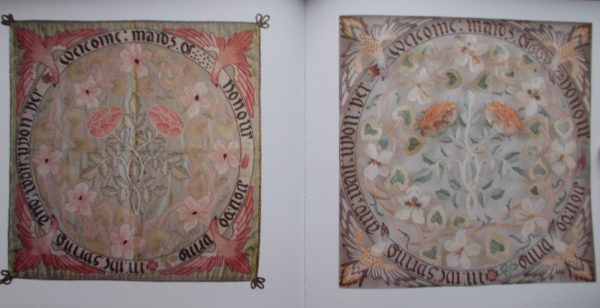
Maid of Honnour panels. Interesting to compare the same design is by May Morris embroidered in different ways and different colours.Satin, split and long and short stitch are used for both.
In 1878 May took up a place at The National Art Training School (later The Royal College of Art) where she specialised in embroidery. In particular she enjoyed researching and sketching Opus Anglicanum, English embroidery at the top of its game and desired across Europe as the Mediaeval luxury good par excellence. Though she shared her parents’ enthusiasm for historically correct stitches, when it came to her own work she liked to use just a few stitches, justifying herself by an assertion that ” [e]xcellence of workmanship does not lie in many curious and difficult varieties of stitch, but in the expressive use of a few ordinary ones”. (Don’t we all have our favourite stitch which we come back to time and again?) Strangely she most enjoyed simple running stitch which she worked very close together – something I’d never noticed until the book pointed it out (and it’s a delight that the photographs in the book are good enough to see this). I’d never thought of using this simple stitch like this and I shall now try doing this. (It may not be easy for her stitches on the underside are so very small) ! Berlin work (cross or tent stitch on a canvas with a pre-printed design) she utterly hated, for its lack of “manual dexterity and aesthetic subtlety”. Canvas kits for sale in Morris and Co. were still ‘printed’ with the laborious prick and pounce method.
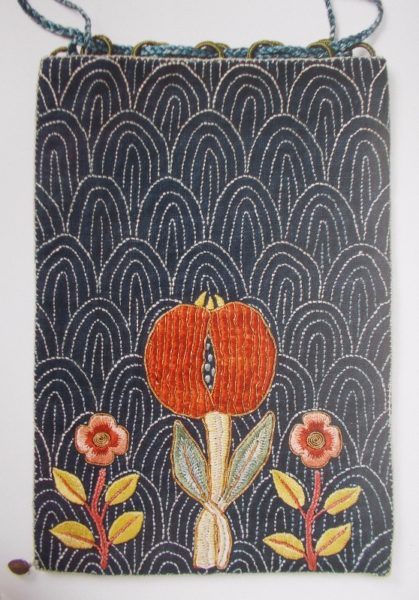
Book bag, designed by May and embroidered by her and Jenny. Coloured silks and gold thread.Long and short stitch, satin stitch, stem stitch, chain stitch, loop stitch, back stitch, buttonhole stitch, laid work and couching. c. 1890s
I885 found May (aged 23) fully in charge of Morris and Co.’s Embroidery Department, from design, through to sales and overseeing staff. She said she was vehemently opposed to division of labour. The designer must also be the maker for if each specialises something is lost at the hand over. By this I feel she meant she herself wanted to both design and make, for though she trained the girls she took on, none of them, with the possible exception of Lily Yeats, sister of the poet, seem to have been allowed free rein to embroider their own designs to any great extent. She was, however, an excellent and enlightened employer.Hours of work were 10am till 6pm and pay was good. (In what was generally recognised as a hugely exploitative industry others were paid not a living wage but a ‘lingering, dying wage’ as one contemporary put it.)
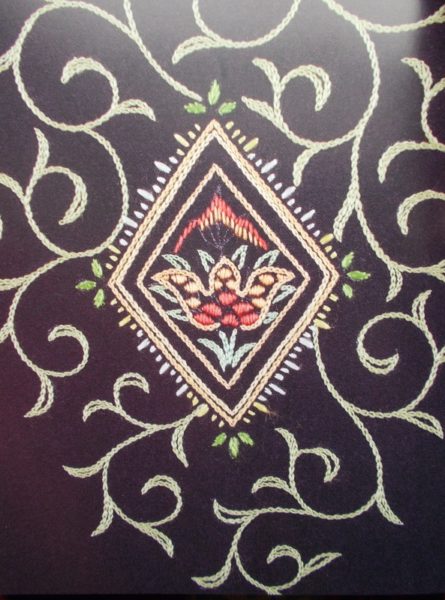
Embroidered detail of an embroidered cloak designed by May Morris. Chain stitch, satin stitch and long and short stitch. c. 1897
Adherence to house style is the main reason May’s own designs have not been fully appreciated until recently. Honeysuckle is now recognised to be her design. Linda Parry usefully points out that May tended to use cottage garden and hedgerow plants while William Morris went for the more showy plants like acanthus and exotic pomegranate. The bed hanging at Kelmscott Manor is now recognised to be her design as well as the much loved ‘Honeysuckle’ wallpaper. Another difference between father and daughter was that William was not against mass production per se but rather he disliked the poor results of the process. In contrast, you get the feeling May was a total craftswoman, devoted to the process as well as the outcome. Significantly May left the company in the same year William died and from then on she pursued her own interests – teaching, writing, editing and taking on private embroidery projects. Freed from the restraints of house style, some say her best embroidery was produced at this time.
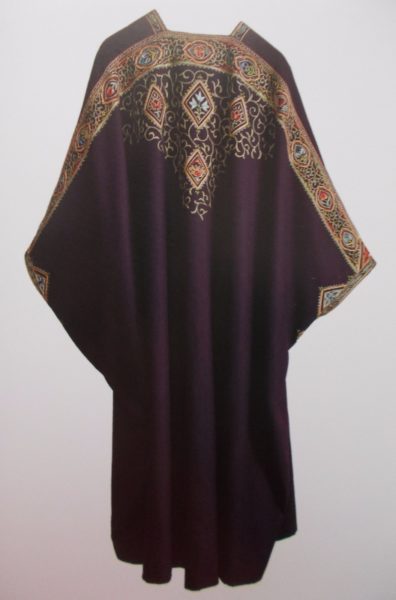
Embroidered cloak 1897: designed by May Morris. chain stitch, satin stitch, long and short stitch
The final phase of her life, from the early years of the C20th to her death saw her take on new craft skills (jewellery and metalwork) and discover a love for travel, crossing the Atlantic and touring America giving lectures on textiles. She forged a deep friendship with a countrywoman, Mary Lobb, often described patronisingly as a former land girl (in fact she wasn’t from a poor background) and even more unkindly described by Evelyn Waugh as an “hermaphrodite”. We now know from the newly discovered journals they enjoyed each other’s company (Jan Marsh says it was a very affectionate relationship) even though Mary was given to sulking if crossed. They enjoyed travelling together to Scotland and Iceland where they slept in tents or in simple crofts while May enjoyed researching textiles. Mary was very manly looking and had a gruff manner which things tended to attract attention from groups of boys wherever they went. But the other side of the coin was that from Mary, May received care and protection. For many years she had been the giver of care – whether to her father’s firm, her father’s reputation, her mother (until 1916) or her sister, disabled with epilepsy, until 1935, it must have been pleasant to have someone looking after her. May died in 1938 and, though more than 10 years younger than May, Mary herself died on a few months later.**
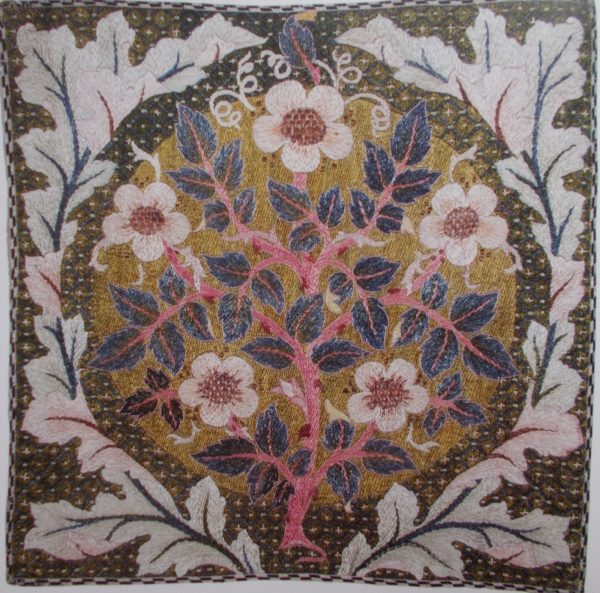
Rose wrest panel c. 1890 : designed by William Morris, embroidered by May Morris. Darning stitch, satin stitch and long and short stitch.
This post has focused on embroidery. I haven’t mentioned May’s political activity. Do read the book for a more rounded picture.
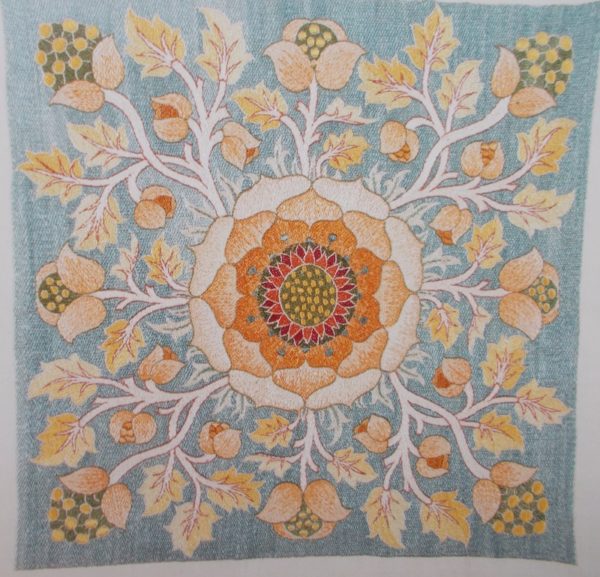
Tudor rose panel c. 1980. Designed but not embroidered by May Morris. Darning stitch, stem stitch and long and short stitch.
May Morris Arts and Crafts Designer (pulished 2017 by T & H in association with the V & A). Introduction by Lynn Hulse; written contributors: Rowan Bain, Hanne Faurby, Jenny Lister, Jan Marsh & Anna Mason.
*See Lynne Truss’s wonderful novel “Tennyson’s Gift” for the longuers suffered by Julia Margaret Cameron’s victims, oops, I mean sitters.
**For fascinating information about Miss Lobb, do look at http://’The Eclectic Collection of Miss M.F.V. Lobb’ : Simon Evans (PDF 1 MB) https://www.llgc.org.uk/fileadmin/…/docs…/cgr_erth_XXXVI_rhif4_2017_2.pdf . Simon Evans is Curatorial Assistant of the National Collection of Welsh Photographs and he did a bit of sleuthing when he came across a series of photographic albums which Miss Lobb had donated to the National Museum of Wales. He gives a lively account of Mary’s life, including a wonderful story told by Sir Basil Blackwell about how Mary talked him into publishing 2 further volumes of May’s already 24 strong Collected works of William Morris,
“Now look here, Mr. Blackwell, you are worrying May, and I won’t have her worried. You’ve got to publish all that stuff. Don’t think I care a snap for the writings. I hate old William Morris, dreadful old bore, but I’ll not have May worried!”
